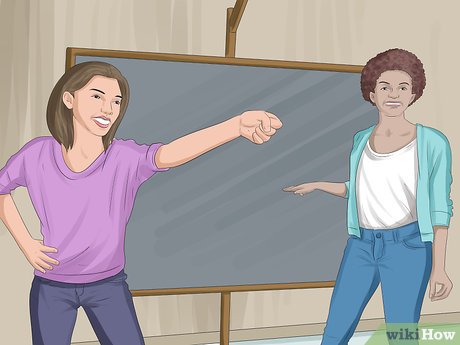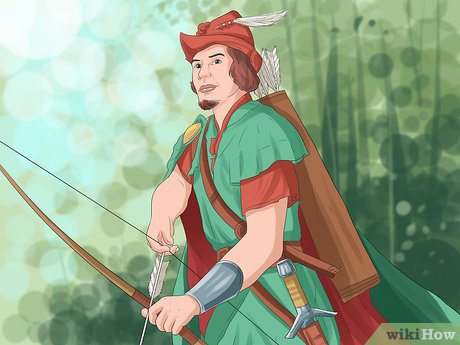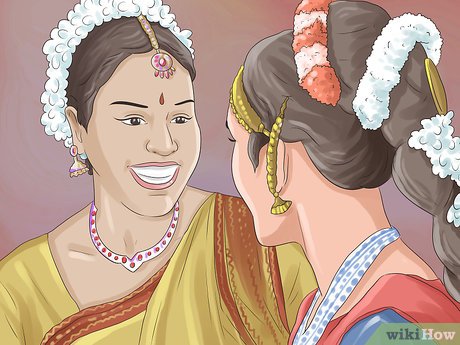How to Roleplay
Learning Text-Based Roleplaying
-
 Choose text-based roleplaying if you like to write fiction or fanfiction. It is essentially the same thing, except that you will be writing the story with at least one other person. When you do text-based roleplaying, you take on the role of a character, and write his or her actions and reactions to other characters and events. Here is an example of what a roleplay might look like:
Choose text-based roleplaying if you like to write fiction or fanfiction. It is essentially the same thing, except that you will be writing the story with at least one other person. When you do text-based roleplaying, you take on the role of a character, and write his or her actions and reactions to other characters and events. Here is an example of what a roleplay might look like:
fanfiction4ever:
Jane was breathless as she hurried to school through the pouring rain. She had forgotten her umbrella at home, and it was too late now to go back and get it. She was soaked and cold.
roleplay_queen:
John saw Jane dash across the school yard, and ran over to her. "Hey, Jane!" he called, "Wait up!" He then pulled out his umbrella, and held it over both their heads. "Here," he said, "Let's walk to class together.
fanfiction4ever:
Jane blushed as John stepped closer to her, so that both of them could fit under the umbrella. She had always had a crush on him, but too afraid of rejection to admit it. "T-thank you, John," she said, and slipped her arm through his. -
 Find a place to roleplay on and obey its rules. There are many websites that allow roleplaying. Some of them are entire websites dedicated to roleplaying, while others have roleplaying sub-forums, such as GaiaOnline and Neopets. Pick a site that suits your interests the most. You will be prompted to create an account and log in.
Find a place to roleplay on and obey its rules. There are many websites that allow roleplaying. Some of them are entire websites dedicated to roleplaying, while others have roleplaying sub-forums, such as GaiaOnline and Neopets. Pick a site that suits your interests the most. You will be prompted to create an account and log in.- Some websites are geared towards only certain types of roleplays, while others allow a broader spectrum. For example, you may find a site that focuses only on vampire-themed roleplays.
- You can play with people you already know, or play with people you don't know. Roleplayers often become best friends!
- Wherever you choose to roleplay, be sure to read the rules and respect them. Breaking these rules can result in suspension or even banning.
-
 Learn the terminology in the roleplaying community. The terms might vary depending on where you choose to roleplay, but in general, they are the same. Here are some common terms you might see:
Learn the terminology in the roleplaying community. The terms might vary depending on where you choose to roleplay, but in general, they are the same. Here are some common terms you might see:- RP: stands for roleplay. You will often see this in search threads.
- OC and Canon: "OC" stands for "original character," while "canon" refers to a character from an existing book, game, or movie, such as Harry Potter, Cloud Strife, or Tony Stark.
- Pairing: this refers to two characters in an rp; they interact with each other the most, and often end up in a relationship.
- OOC: stands for "Out of Character." It is usually followed by a colon to signify the writer him/herself speaking. People use these for comments and questions about the rp.
- Literate, Semi-literate, and Advanced-literate: refer the amount of writing expected per post. These terms are arbitrary, as every one has different ideas of what means what. In general, "semi-lit" refers to posts that are less than a paragraph, and "advanced-lit" refers to posts that are several paragraphs long.
-
 Understand the main types of text-based roleplaying. Besides genre, roleplays fall into different categories: fandom, original, group, and one-on-one. You should choose one that appeals the most to you.
Understand the main types of text-based roleplaying. Besides genre, roleplays fall into different categories: fandom, original, group, and one-on-one. You should choose one that appeals the most to you.- Fandom: an rp based on an existing universe from a book or movie, such as Harry Potter or The Avengers. It can contain both canon and original characters.
- AU: stands for "Alternate Universe." It is a sub-category of "Fandom," and usually contains some changes, such as reversed genders or the characters are all cats.
- Cross-Over: a sub-category of "Fandom." It is a combination of two or more fandoms. For example: Harry Potter and Hunger Games.
- Original: an rp based on a completely original setting that the roleplayers make up. It can be anything: fantasy, historical, real-life, etc.
- Group: an rp between a group of three or more people. They can be fast-paced.
- One-on-One: an rp between two people. It is often written as 1x1, and may contain 1 to 2 pairings.
- Fandom: an rp based on an existing universe from a book or movie, such as Harry Potter or The Avengers. It can contain both canon and original characters.
-
 Create your character, if needed. If you are playing a canon character, then you will not need to create a character for the rp; you should be prepared to portray the canon character as accurately as possible, however. When creating an original character, you will need to make them believable; if you are in a group rp, you may need to submit them to the creator for approval. Consider the following when creating your character:
Create your character, if needed. If you are playing a canon character, then you will not need to create a character for the rp; you should be prepared to portray the canon character as accurately as possible, however. When creating an original character, you will need to make them believable; if you are in a group rp, you may need to submit them to the creator for approval. Consider the following when creating your character:- Physical appearance: Describe your character's hair, eye, skin color, and whatever else is most important to you. This will help other writers to visualize your character. You can also use an image instead, if permitted.
- Personality: What is your character like, and how do they act around other characters? You should also think about your character's goals, motives, and desires.
- Likes and dislikes: What sorts of things does your character like and dislike/fear? It could be as simple as a love for chocolate and a fear of spiders. It could be as complex as having a hobby (ie: painting) and having a fear (ie: being abandoned).
- Skills and talents: Everyone is good at something, and your character should too! It might be a good idea to include something your character is bad at in order to make them more believable.
- Backstory: This will root your character in the fictional world. You will need to consider your character's history, family life, occupation, and so forth.
-
 Make your character believable and realistic. In the rp world, flawless characters—called "Mary Sues" or "Gary Stues"—have a notorious reputation and are extremely frowned upon. Create a character with both positive and negative traits. For example: your character is smart but too shy to speak up in class and show off her intelligence.
Make your character believable and realistic. In the rp world, flawless characters—called "Mary Sues" or "Gary Stues"—have a notorious reputation and are extremely frowned upon. Create a character with both positive and negative traits. For example: your character is smart but too shy to speak up in class and show off her intelligence.- Add a fun quirk or two! Characters that have unusual approaches to solving problems, odd habits, or strange mannerisms can make your character compelling and interesting to others.
- If you are creating a character for a fandom rp, try to blend them into the fandom's world as much as possible. Don't make them too similar to an existing character, however!
-
 Choose between a narrative and script style. Some roleplayers prefer to write using a narrative style, which reads like a typical book. It is the most popular style. Others prefer a screenplay style, which reads like a script. It is most suitable for fast-past roleplays. Here's an example of what a screenplay style roleplay might look like:
Choose between a narrative and script style. Some roleplayers prefer to write using a narrative style, which reads like a typical book. It is the most popular style. Others prefer a screenplay style, which reads like a script. It is most suitable for fast-past roleplays. Here's an example of what a screenplay style roleplay might look like:
fanfiction4ever:
Jane: *running breathlessly through the rain*
roleplay_queen:
John: Hey, Jane! Wait up! *runs over and pulls out umbrella* Here *open umbrella* Let's walk to class together.
fanfiction4ever:
Jane: *blushes and gets under the umbrella* O-okay! -
 Use concrete details and ample description while writing. This will immerse yourself and fellow roleplayers in the fictional world. At the same time, you'll want to avoid rambling, as this can make the other person lose interest.
Use concrete details and ample description while writing. This will immerse yourself and fellow roleplayers in the fictional world. At the same time, you'll want to avoid rambling, as this can make the other person lose interest.- Use the five senses: sight, touch, smell, hearing, and taste.
- Describe the setting: weather, temperature, location, and important surrounding objects.
- Use gestures: what are your characters doing/thinking? How do they walk, talk, and position themselves?
-
 Contribute to the plot. This is especially important when doubling; don't expect your partner to do all the work. Don't just respond to everything he or she writes; add something new to your posts as well. If your partner is doing all the work, eventually he or she will run out of ideas and get tired or drained.
Contribute to the plot. This is especially important when doubling; don't expect your partner to do all the work. Don't just respond to everything he or she writes; add something new to your posts as well. If your partner is doing all the work, eventually he or she will run out of ideas and get tired or drained.- Rps where two people are contributing to the plot are more interesting than rps where one person is doing all the work.
-
 Read what other people write, wait your turn, and post a replay. In text-based roleplaying, everyone writes out what their character says, thinks, and does, and posts it, usually in a forum. If you are doing a one-on-one roleplay, this may be in an instant messenger or even email. When your turn comes, post your character's part of the story.
Read what other people write, wait your turn, and post a replay. In text-based roleplaying, everyone writes out what their character says, thinks, and does, and posts it, usually in a forum. If you are doing a one-on-one roleplay, this may be in an instant messenger or even email. When your turn comes, post your character's part of the story.- Post as soon as you can. If you are unable to post in a timely manner, let your roleplay partner or the group leader know.
- Do not pester people for replies. This can be seen as annoying. Wait a week before asking for a reply; sometimes people forget or get busy.
- Don't ditch a roleplay without a word. This can be seen as very rude in the roleplay community. If you get tired of the roleplay and don't want to do it anymore, be upfront about it. Politely tell the person you are roleplaying with that you are no longer interested.
-
 Know what doubling is. Doubling occurs in one-on-one roleplays, where there are two pairings: your pairing and your partner's pairing. These pairings are often romantic. Each person plays their desired character and a character of their partner's choosing. For example, if you were doing an Avenger's rp, the pairings might be: Steve Rogers x your OC, and Tony Stark x your partner's OC. In this case, you'd be playing your OC and Tony Stark. Your partner would be playing their OC and Steve Rogers. Here is an example of what doubling might look like:
Know what doubling is. Doubling occurs in one-on-one roleplays, where there are two pairings: your pairing and your partner's pairing. These pairings are often romantic. Each person plays their desired character and a character of their partner's choosing. For example, if you were doing an Avenger's rp, the pairings might be: Steve Rogers x your OC, and Tony Stark x your partner's OC. In this case, you'd be playing your OC and Tony Stark. Your partner would be playing their OC and Steve Rogers. Here is an example of what doubling might look like:
roleplay_queen:
John grinned as Jane slipped her arm through his, and began to lead her to class. "Hey, Jane," he said at last. "I was wondering if you wanted to come to homecoming this weekend with me." His heart pounded in his chest as he waited for her reply.
Meanwhile, Mary was hurrying through the halls, trying to get to her class. She was running late again, but wasn't her fault. Elizabeth and her gang had stolen her bag earlier that morning. She got to class moments before the first bell and sat down.
fanfiction4ever:
Jane's eyes widened at John's invitation, and she could hardly believe what she was hearing. This was practically a dream come true! "Oh John!" she said, "I would love to!" And here she thought that John never liked her.
Chris was already sitting at his desk; when he saw Mary enter the classroom, he waved her over, and held up her book bag. He had seen what happened earlier, and managed to get it back from Elizabeth. "Here," he said softly, and gave it to her. -
 Maintain good etiquette when doubling. When to roleplaying, fair is fair. You should give the same amount of attention to both characters that you are playing: your character and the character you are playing for your partner. If you write two paragraphs for your original character, you should write two paragraphs for the other character you are playing (ie: Tony Stark). If you only write two sentences for that other character, you would not be fair to your partner. Just imagine if you only got two sentences back for Steve Rogers!
Maintain good etiquette when doubling. When to roleplaying, fair is fair. You should give the same amount of attention to both characters that you are playing: your character and the character you are playing for your partner. If you write two paragraphs for your original character, you should write two paragraphs for the other character you are playing (ie: Tony Stark). If you only write two sentences for that other character, you would not be fair to your partner. Just imagine if you only got two sentences back for Steve Rogers!
Learning Live-Action Roleplaying
-
 Choose live-action roleplaying if you like to act or play fight. Many people like to compare live-action roleplaying to playing "pretend." That is, you hang out with other people and pretend that you are someone else, such as a vampire or a pirate.
Choose live-action roleplaying if you like to act or play fight. Many people like to compare live-action roleplaying to playing "pretend." That is, you hang out with other people and pretend that you are someone else, such as a vampire or a pirate. -
 Find a type of live-action roleplay that interests you. Some live-action roleplays are action-based, where you fight opponents with boffers (weapons made from foam). Others are story-based, where you do not touch the other characters. Instead, you decide whether you win or lose a battle by rolling dice, playing rock-paper-scissors, or comparing character stats.
Find a type of live-action roleplay that interests you. Some live-action roleplays are action-based, where you fight opponents with boffers (weapons made from foam). Others are story-based, where you do not touch the other characters. Instead, you decide whether you win or lose a battle by rolling dice, playing rock-paper-scissors, or comparing character stats.- Story-based live-action roleplays are also called "theater-style" or "freeform."
- Some live-action meet regularly in a public area, while others meet seldom (ie: once a month or once a year) in a staged area, such as a campground or hotel.
-
 Understand the terminology. When you first enter the world of LARPing, you may hear certain terms that are completely new to you. Most of them are pretty self-explanatory, but some might be confusing. Different groups might have different terms for certain things, but the following are the most common:
Understand the terminology. When you first enter the world of LARPing, you may hear certain terms that are completely new to you. Most of them are pretty self-explanatory, but some might be confusing. Different groups might have different terms for certain things, but the following are the most common:- LARP: stands for "live-action roleplay."
- Boffer: a foam padded weapon, commonly used in action-based LARPs.
- Game master: the person in charge of leading the LARP's story. He or she will be in charge of bringing in new characters, dilemmas, etc. They may also be called a "Storyteller," and are common in story-based LARPs.
- NPC: stands for "non-player character." They are unavailable to the other players, and are usually played by the game master.
- PC: stands for "player character." This is the character that you, the LARPer, plays.
- Crew: also called "stagehands." They help the game master setup the event. Some may also play NPCs.
-
 Review the gaming rules. They will vary depending on which group you join. For example, action-based LARPs often have rules against where you can or can't hit a person with a boffer (ie: the head). Story-based LARPs, on the other hand, often have no-touching rules. Breaking these rules may result in disciplinary action, such as a temporary ban or point deduction.
Review the gaming rules. They will vary depending on which group you join. For example, action-based LARPs often have rules against where you can or can't hit a person with a boffer (ie: the head). Story-based LARPs, on the other hand, often have no-touching rules. Breaking these rules may result in disciplinary action, such as a temporary ban or point deduction.- Many LARPs require you to be in character. You have to indicate when you are not in character. How you do this may vary from group to group.
-
 Create your character, and make sure that they fit the LARP's world. Some types of LARPs may have a character sheet for you to fill out, complete with stats like strength, luck, agility, intelligence, etc. Other types of LARPs only require a name and a brief backstory for your character.
Create your character, and make sure that they fit the LARP's world. Some types of LARPs may have a character sheet for you to fill out, complete with stats like strength, luck, agility, intelligence, etc. Other types of LARPs only require a name and a brief backstory for your character.- Some LARPs require costumes. When creating a character, you might want to keep this in mind, especially if you plan on making the costume yourself.
-
 Get a costume, if needed. Some LARPs require you to be in costume at all times, while others do not. In either case, the costume will help make your character more believable, and the world more engaging. Many people find it easier to get into character while they are in costume.
Get a costume, if needed. Some LARPs require you to be in costume at all times, while others do not. In either case, the costume will help make your character more believable, and the world more engaging. Many people find it easier to get into character while they are in costume.- Many action-based LARPs only require costumes for the actual game or battles. They do not require costumes during training sessions.
-
 Stay in-character whenever possible. Typically, you would be in-character when the LARP is taking place; you would be out-of-character before and after the LARP, such as when plans are being made and points are being tallied. If you need to get out of character, such as during an emergency, remember to indicate accordingly; again, how you indicate will depend on the group you join, as they all have different rules.
Stay in-character whenever possible. Typically, you would be in-character when the LARP is taking place; you would be out-of-character before and after the LARP, such as when plans are being made and points are being tallied. If you need to get out of character, such as during an emergency, remember to indicate accordingly; again, how you indicate will depend on the group you join, as they all have different rules. -
 Find a place to roleplay or a group to play with. Most LARPs will have websites telling you where their roleplays take place. Many LARPs have multiple groups in multiple locations, all playing the same game—that is, they use the same character types and rules. If you find a LARP that interests you, look it up and see if it is playing near your city or town. If they don't, then see if you can register a group of your own, and start your own game.
Find a place to roleplay or a group to play with. Most LARPs will have websites telling you where their roleplays take place. Many LARPs have multiple groups in multiple locations, all playing the same game—that is, they use the same character types and rules. If you find a LARP that interests you, look it up and see if it is playing near your city or town. If they don't, then see if you can register a group of your own, and start your own game.- Some LARPs take place at anime, comic book, or science fiction and fantasy conventions. Check the schedule to see if there is one planned. Most cons will post their schedules ahead of time on their website.
-
 Be well-prepared for longer roleplay sessions. Some LARPs take place in public areas, such as a park, and last only a few hours. Others may span over the course of a weekend, and take place at a campground, forest, or lake. Some of these longer LARPs may have accommodation for the players, such as cottages or hotels, but others won't. In these cases, you will need to pack for the trip, and bring items such as: tents, sleeping bags, food, medications, change of clothes, etc.
Be well-prepared for longer roleplay sessions. Some LARPs take place in public areas, such as a park, and last only a few hours. Others may span over the course of a weekend, and take place at a campground, forest, or lake. Some of these longer LARPs may have accommodation for the players, such as cottages or hotels, but others won't. In these cases, you will need to pack for the trip, and bring items such as: tents, sleeping bags, food, medications, change of clothes, etc.- A costume and prop repair kit would be highly recommended for any weekend-long LARP session. Even the sturdiest costumes and props break, and not every place will have a repair station.
-
 Don't be afraid to interact with other people, but don't take the spotlight either. LARPing is all about interaction. Once a session starts, you will walk around and talk with other players, while in character. This means that if you are playing a 100-year-old vampire, you will be using lots of Victorian-era mannerisms. Don't be afraid to go out of your shell, but don't take the spotlight and try to be the center of attention. Let other players talk as well!!
Don't be afraid to interact with other people, but don't take the spotlight either. LARPing is all about interaction. Once a session starts, you will walk around and talk with other players, while in character. This means that if you are playing a 100-year-old vampire, you will be using lots of Victorian-era mannerisms. Don't be afraid to go out of your shell, but don't take the spotlight and try to be the center of attention. Let other players talk as well!!- If this is a combat-based LARP, have your boffer ready, because people might start charging at you. There is not much chatting or "acting" in combat-based LARPs once a battle starts.
- There is no real winner or loser in a story-based LARP, but the last one standing is the winner in a combat-based LARP. Play hard!
Learning Tabletop Roleplaying
-
 Choose tabletop roleplaying if you like video games or storytelling. Many tabletop games focus on the story, but they also focus on building your character. You will typically sit around a table with a group of people, and take turns describing what your character does.
Choose tabletop roleplaying if you like video games or storytelling. Many tabletop games focus on the story, but they also focus on building your character. You will typically sit around a table with a group of people, and take turns describing what your character does.- One of the most popular tabletop roleplay games is Dungeons and Dragons.
-
 Find a game that you want to play. Typically, you can find a game to join online or in your local gaming/hobby shop. Some games require you to be there in person, while others can be played online.
Find a game that you want to play. Typically, you can find a game to join online or in your local gaming/hobby shop. Some games require you to be there in person, while others can be played online.- There are lots of different settings and genres, ranging from fantasy, to science-fiction, to historical, to horror. Some may have other themes too, such as steampunk or western.
- There are lots of game guides and rule books available online, in bookstores, and at libraries. You can always pick one of these up, and start a game with your friends.
-
 Choose a play style that suits you, your personality, and your lifestyle. Some group meet regularly, while others meet occasionally. This can be as often as once a week to a seldom as once a month or only a few times a year. Also, some games are lighthearted and easy-going, while others are very serious and focused.
Choose a play style that suits you, your personality, and your lifestyle. Some group meet regularly, while others meet occasionally. This can be as often as once a week to a seldom as once a month or only a few times a year. Also, some games are lighthearted and easy-going, while others are very serious and focused.- If you are just starting out, a lighthearted, easy-going play style might be the best for you.
- If you are very busy with work and/or school, a group that meets weekly night be too much for you, but a group that meets monthly might be perfect.
-
 Choose a roleplay whose focus appeals to you. Some roleplays will focus more on story or setting, while others will focus more on battle and combat. If you are a very active person, a story-focused roleplay might bore you. On the other hand, if you enjoy a good story, a combat-focused roleplay might not be engaging enough for you. There are three main types of roleplays:
Choose a roleplay whose focus appeals to you. Some roleplays will focus more on story or setting, while others will focus more on battle and combat. If you are a very active person, a story-focused roleplay might bore you. On the other hand, if you enjoy a good story, a combat-focused roleplay might not be engaging enough for you. There are three main types of roleplays:- Game-oriented roleplays focus on leveling characters via challenges. The battles and monsters become more complex as the characters gain more power.
- Simulation-oriented roleplays focus on exploring the setting, genre, or theme. Combat tends to be dangerous in these games.
- Narrative-oriented games focus on how a character's decision affects the story. These games tend to give players more control over setting and story.
-
 Understand the terminology. Every tabletop roleplay will have its own unique set of terms, but there are some terms that remain consistent across all the different games and genres. The most common ones are:.
Understand the terminology. Every tabletop roleplay will have its own unique set of terms, but there are some terms that remain consistent across all the different games and genres. The most common ones are:.- Game master: the in charge of the roleplay. They are the narrator, and lead the story. "Game master" may also be written as "GM" or "Gamemaster."
- Game mechanics: the rules of the roleplay.
- Adventure: the game, but limited to a single story or plot set by the GM.
- Campaign: a series of adventures. It typically follows or continues the story and includes the same characters from previous sessions.
-
 Create your character. How detailed your character is will depend on what game you are playing. Some games will give you complete freedom during character creation, while others will require you to add stats. Some games will also limit what stats you can use based on what class or race you pick for your character.
Create your character. How detailed your character is will depend on what game you are playing. Some games will give you complete freedom during character creation, while others will require you to add stats. Some games will also limit what stats you can use based on what class or race you pick for your character.- Depending on the game you play, you may have to use the 20-sided die to determine your character's stats.
-
 Understand the basics. After you have created your character, the GM will establish the plot and setting. The players will then take turns describing their characters' actions, and the GM will then decide on the consequences of those actions. Sometimes, a 20-sided die will be used to determine the outcome. For example, if your character comes across a treasure chest, the GM may have you roll the die to determine whether or not your character succeeds in opening the chest.
Understand the basics. After you have created your character, the GM will establish the plot and setting. The players will then take turns describing their characters' actions, and the GM will then decide on the consequences of those actions. Sometimes, a 20-sided die will be used to determine the outcome. For example, if your character comes across a treasure chest, the GM may have you roll the die to determine whether or not your character succeeds in opening the chest. -
 Be descriptive but only to a certain point. For the most part, you will be in charge of describing your character's actions, and the GM will be in charge of describing the results of your character's actions. He or she will also be in charge of describing any scene changes. For example, if your character enters a dungeon, the GM may describe the dungeon. He or she may even throw in a monster for your character to battle.
Be descriptive but only to a certain point. For the most part, you will be in charge of describing your character's actions, and the GM will be in charge of describing the results of your character's actions. He or she will also be in charge of describing any scene changes. For example, if your character enters a dungeon, the GM may describe the dungeon. He or she may even throw in a monster for your character to battle.
You should read it
- How to Make a Roleplay Character
- TOP strongest character in One Piece: Burning Blood
- Is there a way to always do Impostor in Among Us?
- The special character for the Pursuit game is to name special characters
- How to fix Character Map not working on Windows
- Detail of the character classes in the game Outriders
- How to Unlock Toon Link Character in Super Smash Bros. Brawl
- How to Do Literate Roleplay
May be interested
- Things you didn't know about 26 types of Pokéball - Part 1
 pokéball is the most important item in pokémon go, allowing gamers to quickly catch pokémon back to their team. the higher the pokéball, the more effective the ability to catch pokémon.
pokéball is the most important item in pokémon go, allowing gamers to quickly catch pokémon back to their team. the higher the pokéball, the more effective the ability to catch pokémon. - 10 tips to help you become a great Pokemon trainer
 in the article below, tipsmake.com will introduce to you some tips to easily become a great trainer in this pokemon go game offline ...
in the article below, tipsmake.com will introduce to you some tips to easily become a great trainer in this pokemon go game offline ... - How to use GoChat application in Pokémon GO
 pokémon go has become a very hot phenomenon since its debut. any information or tricks related to the game are read and applied by players during the process of catching pokémon. and the gochat chat app for pokémon go players brings space to capture pokémon much more interesting.
pokémon go has become a very hot phenomenon since its debut. any information or tricks related to the game are read and applied by players during the process of catching pokémon. and the gochat chat app for pokémon go players brings space to capture pokémon much more interesting. - How to play Pokemon GO in Landscape Mode on the iPhone
 although players can play pokemon go in portrait mode. however, if you want to watch and play games on a large and eye-catching screen, players can switch to playing games in landscape mode.
although players can play pokemon go in portrait mode. however, if you want to watch and play games on a large and eye-catching screen, players can switch to playing games in landscape mode. - The secret to controlling Pokemon Go employees at work
 these days, hr managers are faced with an extremely painful problem that is the status of priority employees playing pokemon go more than work. this has caused a small impact on productivity and efficiency.
these days, hr managers are faced with an extremely painful problem that is the status of priority employees playing pokemon go more than work. this has caused a small impact on productivity and efficiency. - Check out the 'buffalo' Pokémon in Pokémon Go
 each type of pokemon has hp, cp, ability to attack and endure differently. based on these indicators, players can determine as well as choosing the most powerful pokemon for their offensive tactics.
each type of pokemon has hp, cp, ability to attack and endure differently. based on these indicators, players can determine as well as choosing the most powerful pokemon for their offensive tactics. - Sitting home can also locate Pokemon around, do you believe it?
 the tightening of the niantic developers' rules to prevent players from abusing the support tools also brings annoyance, such as those who have no conditions to move much, go away, it is hard to know. get the location of the pokemon around the area they live in
the tightening of the niantic developers' rules to prevent players from abusing the support tools also brings annoyance, such as those who have no conditions to move much, go away, it is hard to know. get the location of the pokemon around the area they live in - 5 undeniable benefits when playing Pokemon Go
 get to know many new people, breathe fresh air, relieve stress, increase concentration thanks to going out for a walk .... are compelling reasons to force you to try pokemon go now .
get to know many new people, breathe fresh air, relieve stress, increase concentration thanks to going out for a walk .... are compelling reasons to force you to try pokemon go now . - Want to earn the fastest Pokécoins in Pokémon Go? So don't miss this article!
 pokécoins in pokémon go play the role of buying items in the store. the more coins you earn, the more likely you are to buy more items. to earn pokécoins, players will have to complete certain tasks or buy real money.
pokécoins in pokémon go play the role of buying items in the store. the more coins you earn, the more likely you are to buy more items. to earn pokécoins, players will have to complete certain tasks or buy real money. - Pokémon systems when fighting in Pokémon Go
 each pokémon system in pokémon go has different strengths, along with a specific weakness. this type of pokémon will have the power to attack the other pokémon, but can defeat the other pokémon. if you know the characteristics of each type, it will be easier to choose which pokémon to battle.
each pokémon system in pokémon go has different strengths, along with a specific weakness. this type of pokémon will have the power to attack the other pokémon, but can defeat the other pokémon. if you know the characteristics of each type, it will be easier to choose which pokémon to battle.








































 How to Become a Nickelodeon Star
How to Become a Nickelodeon Star How to Start a Record Label
How to Start a Record Label How to Make a Successful Instagram Fanpage
How to Make a Successful Instagram Fanpage How to Be Caller Number 10 to a Radio Station
How to Be Caller Number 10 to a Radio Station How to Write a Personal Narrative
How to Write a Personal Narrative How to Quote a Book
How to Quote a Book